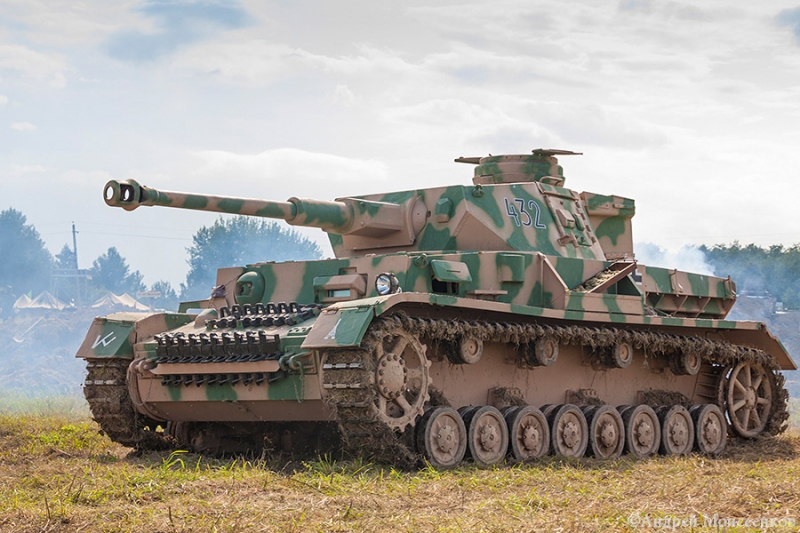
«Panzerkampfwagen IV» («PzKpfw IV», also «Pz. IV»; in the Soviet Union it was also known as the «T-IV») - Medium Tank armored troops of the Wehrmacht during World War II. There is a version, that the Pz IV was originally classified by the German side, as a heavy tank, but it is not confirmed by documents.
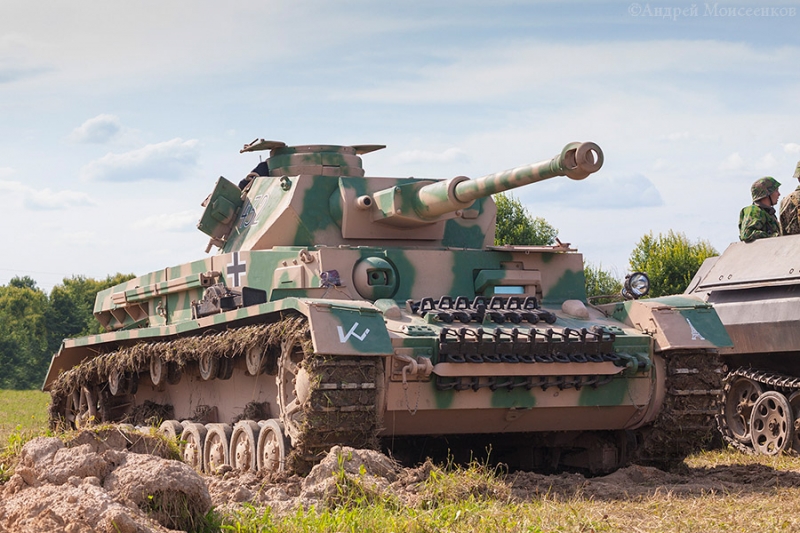
The most massive tank of the Wehrmacht: released 8 686 machines; serially produced from 1937 by 1945 year in several versions. Constantly increasing arms and reservation tank in most cases allows PzKpfw IV tanks to effectively confront the same class. French tanker Pierre Dana wrote about PzKpfw IV (modification, on that moment, even with a short-75-mm cannon): “This medium tank exceeded our B1 and B1 bis in all respects, including weapons and, to a certain degree, armor”.
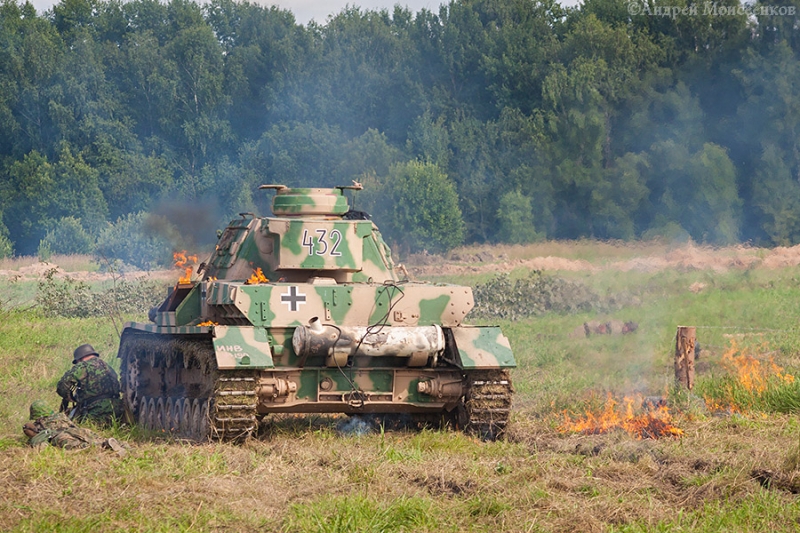
History of creation
Under the terms of the Treaty of Versailles, defeated in World War I Germany was forbidden to have armored forces, except for a small number of armored cars for the police needs. But despite this, already with 1925 year Reichswehr arms Office of secret work was carried out on the creation of tanks. Until the early 1930s, these developments did not go further construction of prototypes, both because of the inadequate performance last, and because of the weakness of the German industry of the period. Nevertheless, by the middle 1933 , the German designers managed to create his first serial tank - Pz.Kpfw.I and start its serial production for 1933-1934 years. Pz.Kpfw.I, with his arms and machine-gun crew of two, I considered only as a transitional model towards the construction of more sophisticated tanks. Development of the two of them began in 1933 year - more powerful "transitional" tank, Pz.Kpfw.II future and a full tank battle, future Pz.Kpfw.III, armed 37mm cannon, intended mainly to fight other armored vehicles.
Due to the limitations of the original weapons Pz.Kpfw.III, it was decided in addition to create a tank fire support, with a long-range gun with a powerful fragmentation projectile, capable of striking an anti-defense beyond the reach of other tanks. In January 1934 , the Office of arms design competition was organized to create a car of this class, whose mass is not exceeded 24 tons. Since work on the armored vehicles in Germany at that time were still under wraps, new project, like the rest, It was given the code-naming "machine support" (it. Begleitwagen, usually abbreviated to B.W.; a number of sources are incorrect name it. Bataillonwagen and it. Bataillonfuehrerwagen). From the outset, the development of projects for the competition engaged the firm "Rheinmetall" and "Krupp", later they were joined by "Daimler-Benz" and M.A.N. Over the next 18 months of their developments presented all firms, and "Rheinmetall" project under the designation VK 2001(Rh) It was in 1934-1935 the even made in the metal in the form of a prototype.
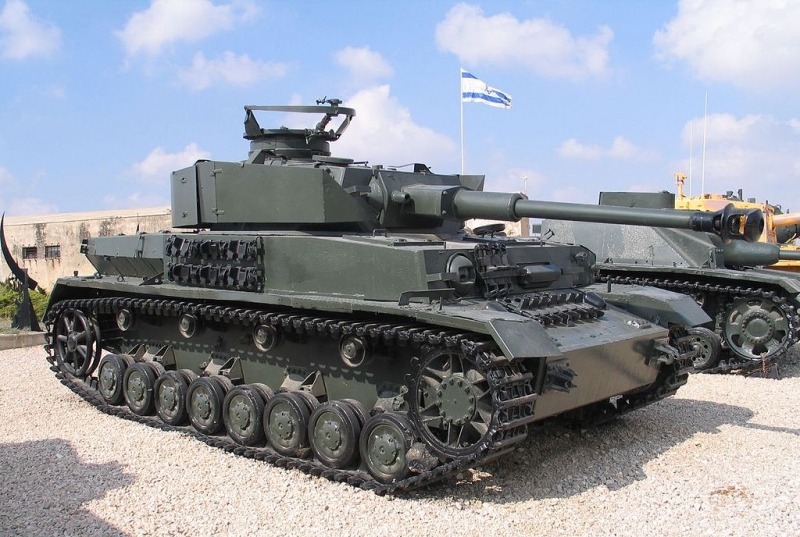
tank Pz.Kpfw. IV Ausf. J (Museum of armored vehicles - Latrun, Israel)
All submitted projects were undercarriage staggered road wheels of large diameter and the lack of support rollers, with the exception of the same VK 2001(Rh), generally inherited chassis interlocked pairwise road wheels of small diameter and a skirt from an experienced heavy tank Nb.Fz. The best of them as a result of the project has been recognized by "Krupp» - VK 2001(K), but arms management was not satisfied with his spring suspension, they demanded to replace the more sophisticated torsion. However, "Krupp" insisted on the use of undercarriage with rollers interlocked pairwise average diameter on a spring suspension, borrowed from a rejected prototype Pz.Kpfw.III her own development. To avoid the inevitable when processing project under torsion suspension delays in the start of production of the much-needed military tank, Arms control has been forced to accept the offer "Krupp". After the subsequent completion of the project, "Krupp" has received an order for the production of pre-party of a new tank, by that time received the designation "an armored vehicle with a 75-mm gun" (it. 7,5 cm gun armored car) or, cross-cutting notation, taken a while, "Experimental model 618" (it. Test car 618 or Vs.Kfz.618). From April 1936 of the year, Tank has got its final designation - Panzerkampfwagen IV or Pz.Kpfw.IV. Besides, he was assigned to the index Vs.Kfz.222, previously owned Pz.Kpfw.II.
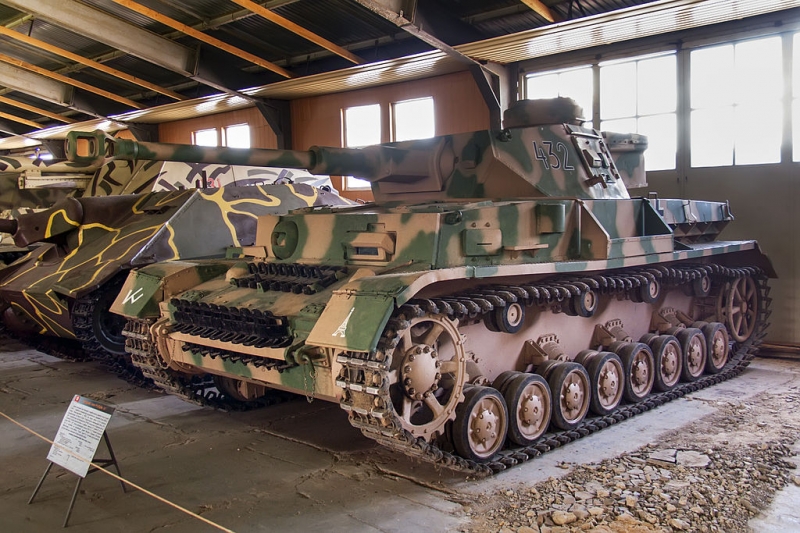
Танк PzKpfw IV Ausf G. Kubinka Tank Museum.
Mass production
Panzer IV Ausf.A - Ausf.F1
The first few Pz.Kpfw.lV is "zero" series were made in 1936-1937 at the factory "Krupp" in Essen. Serial release of the first series, 1.Serie/B.W., It was launched in October 1937 year at the "Krupp-grusonia" in Magdeburg. Total to March 1938 It had been issued 35 Tanks of this modification, designated as Panzerkampfwagen IV Ausführung A (Ausf.A - «model A»). According to the unified system of the German armored tank designations received index Sd.Kfz.161. Ausf.A tanks in many ways is still the pre-series aircraft and carried bulletproof book, does not exceed 15-20 mm and weakly protected observation equipment, especially in the commander's cupola. At the same time, on Ausf.A already identified the main design features Pz.Kpfw.IV, and although later the tank was repeatedly subjected to modernization, changes are mainly confined to the installation of more powerful weapons and booking, or to alteration of individual nodes unprincipled.
Immediately after the production of the first series, "Krupp" started production improved - 2.Serie / B.W. or Ausf.B. The most noticeable external difference of this modification of tanks was a straight upper endplate, without prominent "chopping" of the driver and with the elimination of exchange rate gun, who was replaced by observation devices and hatches for shooting from the sidearms. Was improved and the construction of viewing devices, above all the commander's cupola, received armored shutter, and the inspection unit of the driver. According to others the same, the new commander's cupola was introduced already in the production process, so that part of Ausf.B tanks carrying commander's cupola of the old type. Small changes were made and seat covers and various hatches. Head-to book on the new modification has been brought to 30 mm. The tank was also more powerful engine and a new 6-speed gearbox, which significantly raise its maximum speed, And its power reserve has also increased. At the same time, Ausf.B ammunition was reduced to 80 to the gun shots and 2700 machine gun bullets, instead, respectively, 120 and 3000 of Ausf.A. "Krupp" was given the order for the production 45 tanks Ausf.B, but due to lack of parts, really from April to September 1938 , it was made only 42 machines of this modification.
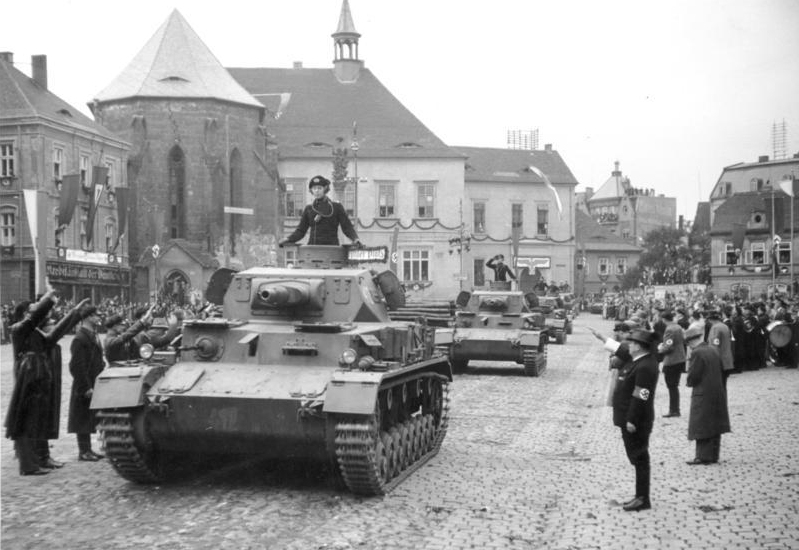
Tank Pz.Kpfw.IV Ausf.A parade, 1938 year.
The first relatively mass modification became 3.Serie / B.W. or Ausf.C. Compared with Ausf.B, changes therein were small - both externally modifications distinguishable only by the presence of an armored casing coaxial gun barrel. Other changes were limited to the motor is changed to HL 120TR HL 120TRM same power, as well as the beginning of the installation of the deflector tanks under the gun barrel, for bending arranged in the antenna housing while turning tower. Total has been ordered 300 Tanks of this modification, but in March 1938 , the order was reduced to 140 units, as a result of September 1938 to August 1939 year produced, According to various sources, 140, or else 134 tanka, whereas 6 chassis were transferred to alterations in the vehicle launched bridges.
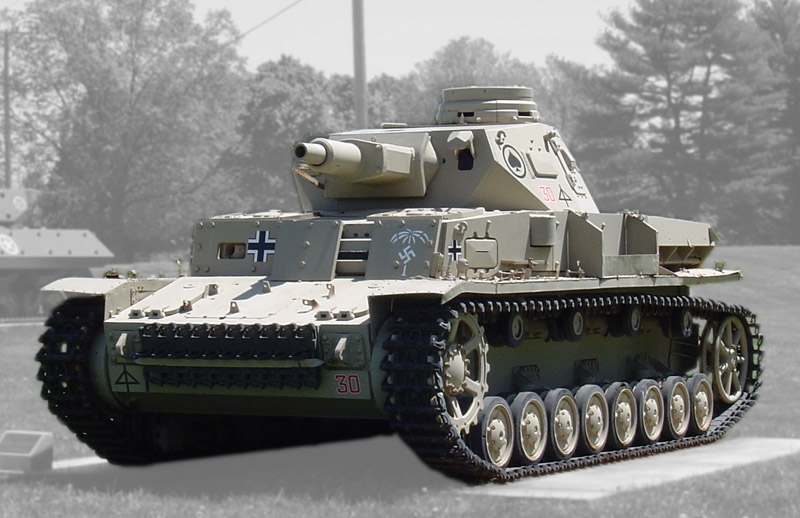
Museum Pz.Kpfw.IV Ausf.D with additional armor
following modification of the machine, Ausf.D, were issued in two series - 4.Serie / B.W. и 5.Serie / B.W. The most noticeable exterior change was the return to the sloping upper front plate housing and course machine gun, who received enhanced protection. Inner mask guns, which proved to be vulnerable to lead spatter bullet Hit, It has been replaced by an external. The thickness of the board and stern armor hull and turret was brought to 20 mm. In January 1938 , the "Krupp" has received an order for the production 200 machines 4.Serie / B.W. and 48 5.Serie/B.W., but in the course of production, October 1939 in May 1941 of the year, the tanks were completed only 229 of them, while the rest 19 We have been allocated for the construction of specialized options. Some of the tanks Ausf.D later release was issued in "tropical" version (it. tropen or Tp.), with additional ventilation openings in the engine compartment. A number of sources suggests are produced in 1940-1941 in parts or in the repair of armor, carried out using fastening bolts 20 mm additional sheets to the upper tank side and frontal plates. According to others, later releases cleanly machine equipped with an additional 20-mm board and 30mm frontal armor plates of the type Ausf.E. Several were Ausf.D 1943 It was rearmed with long-barreled guns KwK 40 L/48, but the converted tanks were used only as a training.
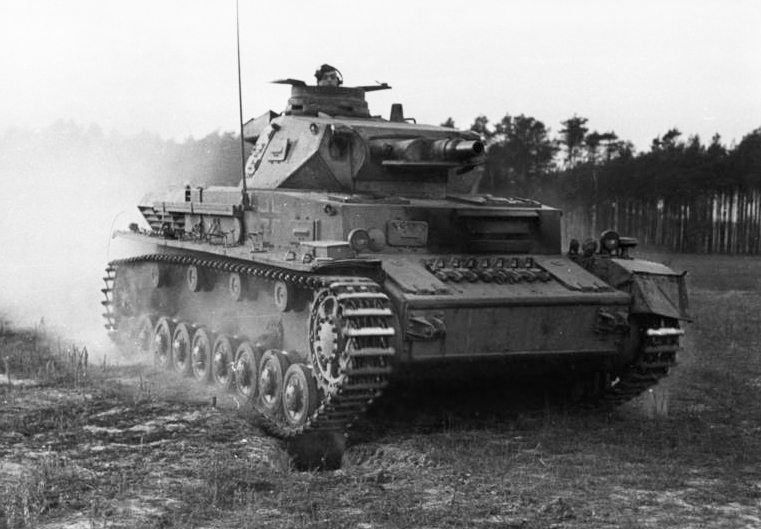
Tank Pz.Kpfw.IV Ausf.B or Ausf.C on exercises. November 1943 of the year.
The emergence of a new modification, 6.Serie/B.W. or Ausf.E, It was due primarily to lack of armor cars early series, demonstrated even during the Polish Campaign. on Ausf.E, the thickness of the bottom end-plate was adjusted to 50 mm, but this has become a standard installation of an additional 30-mm plates of the upper front and 20 mm - over the side plates, although a small part of the tanks earlier releases additional 30-mm plates are not installed. Armor protection of tower, at the same time, It has remained the same - 30 mm for the front plate, 20 mm for side plates and a stern and 35 mm gun mantlet. new commander's cupola was introduced, a vertical thickness from booking 50 to 95 mm. It was also reduced slope turret wall, now produced from a single sheet, without the "influx" of the turret, and the machines later release to the stern of the tower became attached unarmored box equipment. Besides, Ausf.E tanks differed next less significant changes - a new viewing device driver, simplified driving and guiding wheels, an improved structure of various manhole and inspection hatches and introduction tower fan. The order for the sixth series was Pz.Kpfw.IV 225 units and was carried out in full in the period from September 1940 to April 1941 of the year, in parallel with the production of tanks Ausf.D.
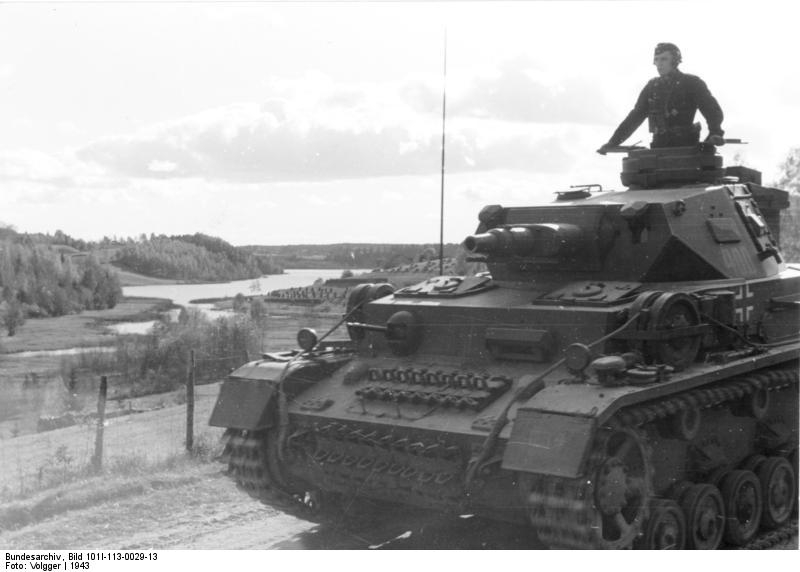
Pz.Kpfw.IV Ausf.F. Finland, 1941 year.
Screening of additional armor (on average 10-12 mm), It is applied in previous versions, It was irrational and only seen as a temporary solution, and that was the cause of the following modifications, 7.Serie/B.W. or Ausf.F. Instead of using a hinged armor, thickness of the frontal upper housing plate, End-plate towers and guns mask was brought to 50 mm, and the thickness of the sides of the body and the sides and stern of the tower - to 30 mm. Polyline upper front hull plate was again replaced by a straight line, but this time with the preservation of the course machine gun, and side hatches tower received a double flap. Because, that the mass of the tank after changes rose 22,5 % compared with Ausf.A, to reduce the ground pressure over wide tracks were introduced. other, less noticeable changes, They included the introduction of ventilating air intake in the frontal average for brake cooling, otherwise silencing arrangement and slightly changed due to the thickening armor vision devices and installing the course gun. Ausf.F on modifications to the production Pz.Kpfw.IV first joined other firms, in addition to "Krupp". The latter received the first order for 500 machines seventh series, later orders 100 and 25 Units received firm "Vomag" and "Nibelungenverke". Of this amount,, from April 1941 to March 1942 of the year, to switch production to modify Ausf.F2, it was released 462 tanks Ausf.F, 25 of which were at the factory converted into Ausf.F2.
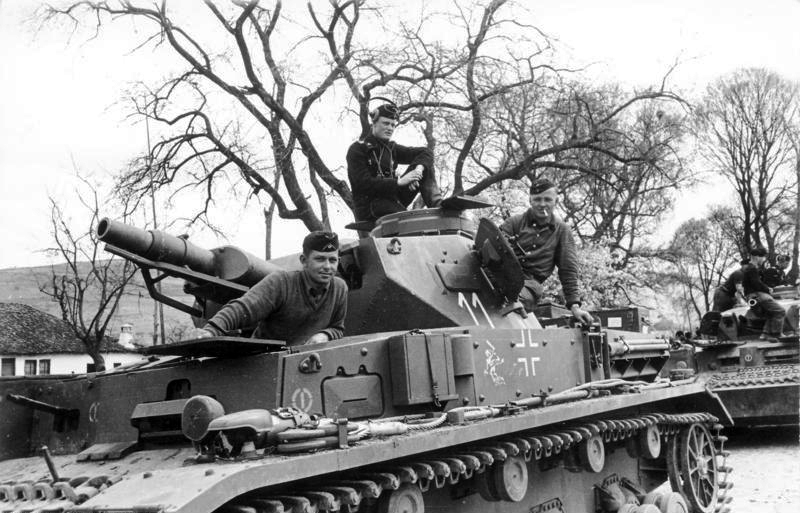
Танк Pz.Kpfw.IV Ausf.E. Yugoslavia, 1941 year.
Panzer IV Ausf.F2 - Ausf.J
Although the main purpose of the 75 mm gun was Pz.Kpfw.IV destruction skinned, or slabobronirovannyh purposes, the presence in her ammunition armor-piercing projectile allowing the tank to successfully deal with armored vehicles, protected bulletproof or light protivosnaryadnym booking. But against tanks with powerful protivosnaryadnym booking, such as the British "Matilda" or Soviet KV and T-34, it was completely ineffective. Also in 1940 - early 1941 of the year, successful combat use of "Matilda" to intensify efforts to re Pz.Kpfw.IV instrument with the best anti-tank capabilities. FROM 19 February 1941 year on the personal orders of A. Hitler work began on the tank armament 50 mm gun Kw.K.38 L / 42, Sets also Pz.Kpfw.III, We continue to work to strengthen weapons Pz.Kpfw.IV progressed well under his control. In April, one Pz.Kpfw.IV Ausf.D was perevooruzhon latest, more powerful, 50-mm cannon Kw.K.39 L / 60 to demonstrate to Hitler for his birthday, 20 April. release of the series was even scheduled from 80 Tanks with weapons from August 1941 of the year, but by the time the interest Arms Management (Heereswaffenamt) shifted to 75-mm long-barreled guns, and these plans refused.
Since Kw.K.39 already been approved as weapons for Pz.Kpfw.III, Pz.Kpfw.IV was decided to choose an even more powerful tool, which could not be installed on Pz.Kpfw.III with its smaller diameter turret. More from March 1941 , the "Krupp" as an alternative to the 50-mm gun, consider a new 75-mm cannon with a barrel length 40 calibres, is intended for re-assault guns StuG.III. At a distance of 400 m is punched 70 mm armor meeting at an angle of 60 °, but as the management of arms required, to gun barrel does not protrude beyond the dimensions of the hull, its length was reduced to 33 calibres, which resulted in a decrease to armor penetration 59 mm under the same conditions. development of armor-piercing projectile sabot has also been planned with separable tray, Punches 86 mm armor under the same conditions. Work on upgrading Pz.Kpfw.IV new instrument were successfully, and in December 1941 , the first prototype was built with a gun 7,5 cm Kw.K. L/34,5.
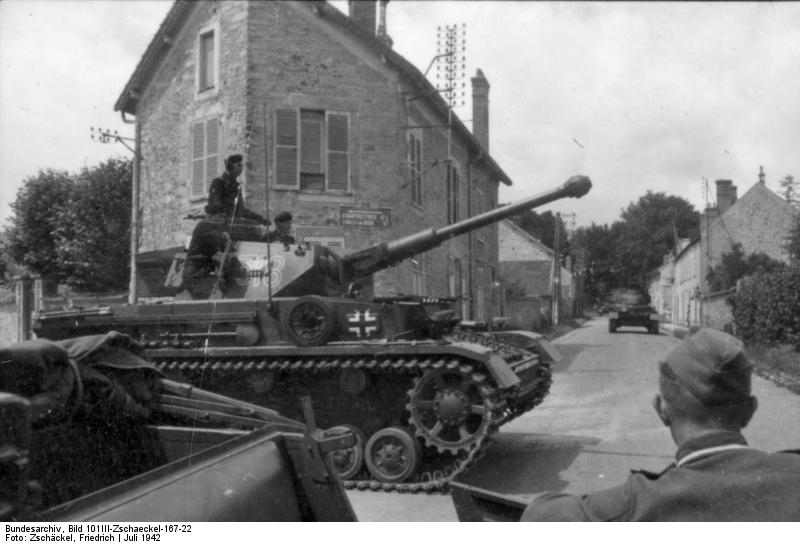
Танк Pz.Kpfw.IV Ausf.F2. France, July 1942 of the year.
Meanwhile, the invasion of the Soviet Union, during which the German forces encountered with T-34 and SW, low vulnerability to the main tank and anti-tank guns and thus Wehrmacht carrier 76mm cannon, punched frontal armor of German tanks, consisted then in service Panzerwaffe virtually any real-world distances battle. Tank Special Commission, sent to the front in November 1941 , to examine this question, It recommended re German tanks such instrument, that would allow them to hit the Soviet machine with large distances, staying out of range of effective fire last. 18 November 1941 year has initiated the development of a tank gun, similar in their capabilities to the new 75-mm anti-tank gun Pak 40. such an instrument, originally received the designation Kw.K.44, It was developed jointly by "Krupp" and "Rheinmetall". The trunk is passed to it from the anti-tank weapon unchanged, but since the last shots were too long for use in the tank, thick and short sleeve was designed for tank gun, which resulted in alteration breech gun and to reduce the overall length of the barrel to 43 calibres. Kw.K.44 received also different from the anti-tank gun, single chamber muzzle brake spherical shape. In such a weapon it was accepted into service as the 7,5 cm Kw.K.40 L/43.
Pz.Kpfw.IV with a new instrument was originally designated as a "converted" (it. 7.Series / B. W. Tag или Ausf.F Tag), but soon received the designation Ausf.F2, while Ausf.F machines with the old guns were called Ausf.F1, to avoid confusion[28]. Designation single tank system wherein was changed to Sd.Kfz.161 / 1. Except as otherwise guns and related small changes, such as installing a new sight, new pilings for shots and slightly modified reservation is recoil gun devices, Ausf.F2 early releases were identical tanks Ausf.F1. After a month break, associated with the transition to a new modification, Ausf.F2 release started in March 1942 , and it lasted until July of the same year. All were released 175 Tanks of this option, and more 25 pereoborudovano IZ Ausf.F1.
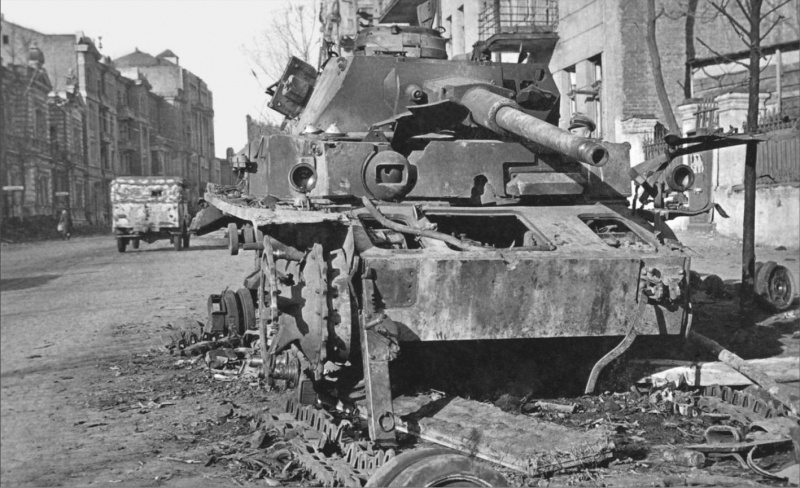
tank Pz.Kpfw. IV Ausf. G (board room 727) 1-Panzer-Grenadier Division "Leibstandarte SS Adolf Hitler". The car was hit gunners 4th Battery 595 th anti-tank artillery regiment near Street. Sumy, Kharkov, on the night 11 on 12 Martha 1943 of the year. On the frontal armor plate, almost in the center, seen from the two inlets 76 mm projectiles.
The appearance of the following modifications Pz.Kpfw.IV initially was not caused by any changes in the design of the tank. In June - July 1942 by order of the Office of arms designation Pz.Kpfw.IV with long-barreled guns was changed to 8.Serie / B.W. or Ausf.G, and in October, marking Ausf.F2 was finally abolished and the previously issued tanks of this modification. The first tanks, both issued Ausf.G, in this way, They were identical to their predecessors, but in the course of further proceedings in the design of the tank it has been made all the more changes. Ausf.G early releases still carried on through notation index Sd.Kfz.161 / 1, in the later editions of machines to replace on Sd.Kfz.161 / 2. The first changes, put forward to the summer 1942 of the year, They include a new two-chamber muzzle brake pear-shaped, elimination of viewing devices in the front board slabs and tower inspection hatch loader in its front plate, transfer of smoke grenade launchers aft body on the side of the tower and a system to facilitate start-up in winter conditions.
Since the 50-mm frontal armor Pz.Kpfw.IV still remained inadequate, not providing adequate protection of the 57-mm and 76-mm shells, she was again strengthened, by welding or, the machines later releases, bolting an additional 30-mm plates over the upper and lower end-plate body. The thickness of the end-plate and turret gun mantlet, at the same time, still it was 50 mm and in the further modernization of the tank is not increased. The introduction of additional armor began another Ausf.F2, when in May 1942 year have been released 8 tanks with increased thickness of armor, but proceeded slowly. By November, with reinforced armor it was produced only about half the machines, and only in January 1943 years it has become the standard for all new tanks. Another significant change, on the entered Ausf.G from spring 1943 of the year, was the replacement gun Kw.K.40 L / 43 on Kw.K.40 L / 48 with a barrel 48 calibres, possessed slightly higher armor penetration. Ausf.G production continued until June 1943 of the year, all were released 1687 Tanks of this modification. Of these, some 700 tanks received increased bookings and 412 - gun Kw.K.40 L / 48.
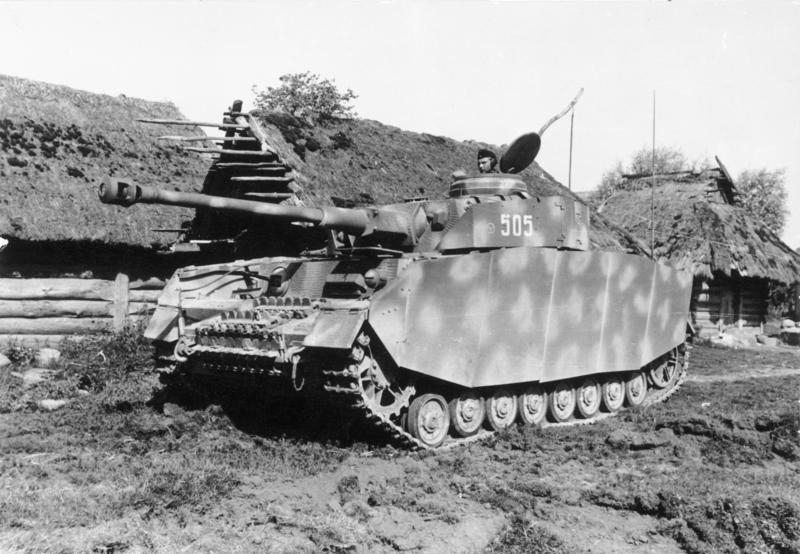
Pz.Kpfw.IV Ausf.H with side screens and coating tsimmeritovym. the USSR, July 1944 of the year.
The following modification, Ausf.H, It became the most mass. The first tanks under this designation, descended from the conveyor in April 1943 of the year, differed from the latter Ausf.G a thickening of the front sheet to the roof of the tower 16 mm and the rear - to 25 mm, as well as reinforced final drive with cast-wheeler, but the first 30 Ausf.H tanks due to delays in the delivery of new components received only thickened the roof. Since the summer of the same year, instead of an additional housing 30mm reservation to simplify manufacturing solid-rolled to 80 mm plates were introduced. Besides, Hinged Spaced Armor were introduced of 5 mm sheets, installs on most Ausf.H. Concerning, as unnecessary were eliminated vision devices in the sides of the hull and turret. From September tanks received a coating vertical tsimmeritom reservation for protection against magnetic mines.
Tanks Ausf.H later releases received turret mount for machine gun MG-42 at the hatch commander's cupola, and a vertical plate instead of the oblique feed, the former on all previous versions of tanks. During the production of various modifications have also been introduced, aimed at simplifying and cheapening manufacturing, neobrezinennye such as introduction and elimination of support rollers periscopic sight device driver. Since December 1943 , the frontal plate body began to connect with on-board connection "in spike", to enhance the resistance of shell results when. Ausf.H production continued until July 1944 of the year. Data on the number of issued tanks of this modification, cited in various sources, slightly different, from 3935 chassis, of which the tanks have been completed 3774, to 3960 chassis and 3839 tanks.
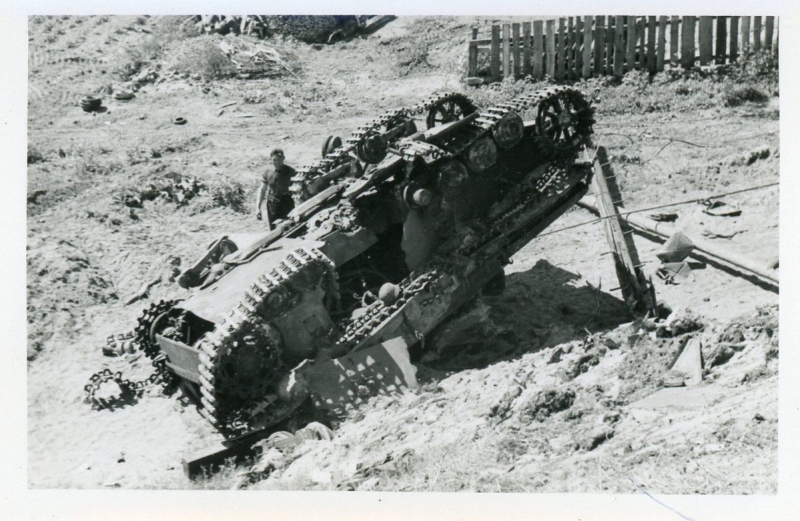
Destroyed on the Eastern Front German medium tank Pz.Kpfw. IV, lying upside down on the roadside. None of the tracks are in contact with the ground, at the same location with no rollers fragment lower housing part, the bottom sheet is torn, the second track is torn off. The upper part of the machine, as far as can be judged, It is not as fatal damage. A typical pattern on a land mine while blasting.
The emergence from June 1944 year on assembly lines modification Ausf.J was connected with the desire as much as possible to reduce the cost and simplify the production of the tank in a worsening of the strategic position of Germany. only, but significant change, different first Ausf.J from last Ausf.H, was the elimination of turning electric tower and related auxiliary carburetor engine with a generator. Shortly after the start of production of new modifications were eliminated pistol ports at the rear and sides of the tower, useless because the screens, as well as the simplified design of other hatches. Since July liquidated on the spot auxiliary engine started to install an additional fuel tank capacity in 200 liters, but struggle with his Dribble was delayed until September 1944 of the year. Besides, 12-mm housing roof started amplify privarkoj additional 16-mm sheets. All subsequent changes were aimed at further simplifying the design, most prominent among them were the rejection of tsimmeritovogo coverage in September, and reducing the number of support rollers to three on the board in December 1944 of the year. Production Ausf.J modifications tanks lasted until near the end of the war, till March 1945 of the year, but the decline in production, associated with the weakening of German industry and the difficulties with the supply of raw materials, led to, that was released only 1758 Tanks of this modification.
The volume of production of the tank T-4

Design
Pz.Kpfw.IV had layout coincident with the placement of transmission compartment and the driver's compartment in the front, engine compartment - stern, and the crew compartment - in the middle part of the machine. The crew consisted of five men: the driver and radio operator-gunner, located in the department of management, and gunner, loader and tank commander, were in the triple tower.
Armor hull and turret
Turret PzKpfw IV made it possible to upgrade the tank gun. Inside the tower housed commander, gunner and loader. the commander of the place is directly under the commander's cupola, gunner was situated to the left of the breech of the gun, loader - right. Additional protection is provided Spaced Armor, Sets are also on board. Commander's cupola at the back of the tower gave the tank a good visibility. The tower had an electric rotation drive.
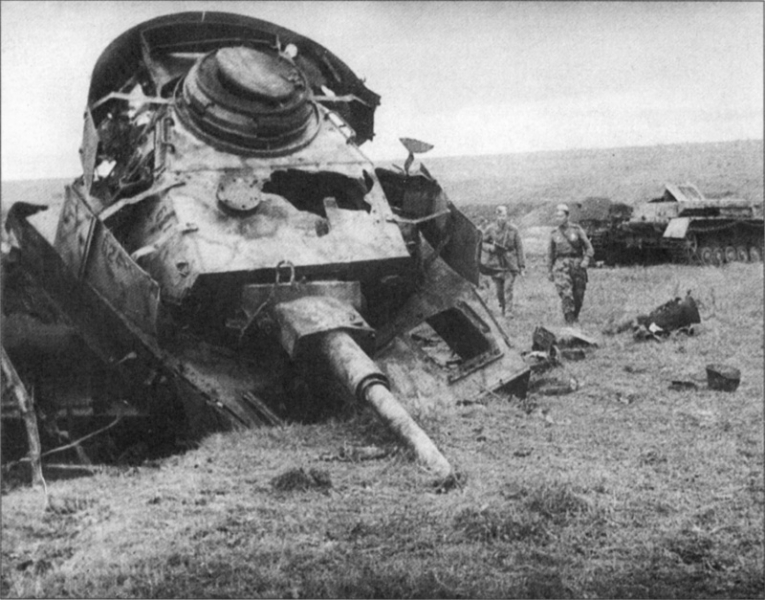
Soviet soldiers considered broken German tank Pz.Kpfw. IV Ausf. n (Single-hatch and the absence of a tower triple-grenade). The tank is painted in three-color camouflage. Orel-Kursk sector.
observation and communication tools
a tank commander in non-combat conditions, usually, conducted surveillance, standing in the hatch of the commander's cupola. In the battle for the review of the area, he has five broad observation slits along the perimeter of the commander's cupola, gave him all-round visibility. Peepholes commander, as with all other crew members, supplied with a protective triplex glass blocks on the inside. On Pz.Kpfw.IV Ausf.A any additional cover peepholes had, but Ausf.B slot armor equipped with sliding shutters; as such inspection commander instruments remained unchanged in all subsequent modifications. Besides, tanks early modifications in the commander's cupola there was a mechanical device for determining the yaw rate target, by which the commander could maintain accurate target designation gunner, who had a similar device. However, due to the excessive complexity, This system was abolished, since modifications Ausf.F2. Vision devices gunner and loader on Ausf.A - Ausf.F consisted of, for each of them: inspection hatch with bronekryshkoy without viewing slots, in the front plate of the tower on both sides of the gun mask; inspection flap with a slot in the front side plates and a viewing slot in the cover board hatch tower. Since Ausf.G, as well as the late release of the Ausf.F2, vision devices were eliminated in the front side plates and the inspection door in the front plate of the loader. On the part of the tank and modifications Ausf.H Ausf.J, in connection with the installation of screens protivokumulyativnyh, vision devices in the sides of the tower were completely eliminated.
The primary means of surveillance for the driver Pz.Kpfw.IV serve a wide viewing slot in the front plate body. From inside the slit glass blocks defended triplex, from the outside at the same Ausf.A she could close the simplest folding armored shutter, on Ausf.B and subsequent modifications smenonnoy sliding shutter Sehklappe 30 or 50, shall also apply to Pz.Kpfw.III. Above the viewing slot on Ausf.A placed periscope binocular viewing device K.F.F.1, but Ausf.B - he was eliminated Ausf.D. On Ausf.E - Ausf.G viewing device will be available in the form of improved K.F.F.2, but since Ausf.H from him again refused. Device deduced in two holes in the front plate and the housing without the need for it shifted to the right. Gunner-radio operator on most versions of any means of viewing a frontal sector, in addition to the gun sight course, I had, but Ausf.B, Ausf.C and parts Ausf.D in place a machine gun was located hatch with viewing slot in it. Similar hatches housed in side plates on most Pz.Kpfw.IV, They are eliminated only Ausf.J in connection with the installation of screens protivokumulyativnyh. Besides, the driver had the position of the tower light, one of the two lamps warn of a turn of the tower on a given board, guns to avoid damage during driving in cramped conditions.
For external communication, Pz.Kpfw.IV platoon commanders and above equipped with VHF radio Fu model 5 and receiver Fu 2. Linear tanks were equipped with only receiver Fu 2. FuG5 had the power of the transmitter 10 W and provide communication range 9,4 km in the telegraph and 6,4 km over the phone. For internal communication Pz.Kpfw.IV all equipped with a tank intercom system for four of the crew members, except for charging.
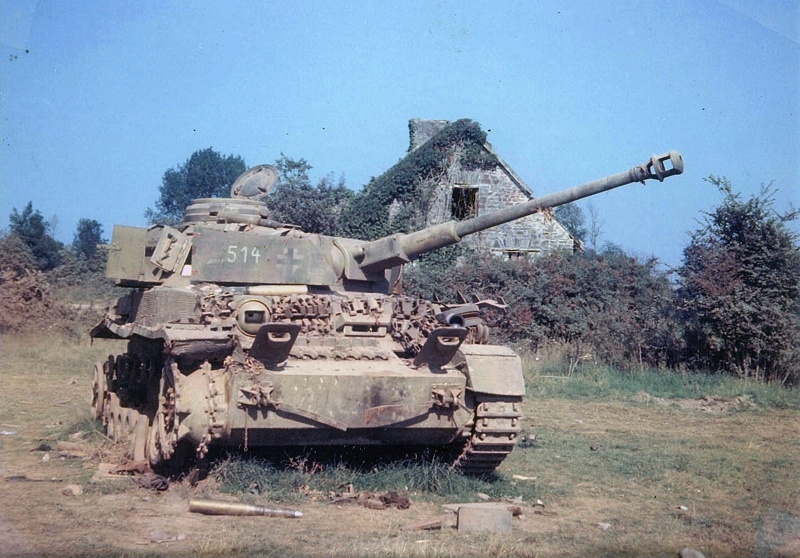
German tank Pz.Kpfw. IV Ausf. H training Panzer (Panzer-Lehr-Division), lined in Normandy. Before the tank is a unitary high-explosive shot Sprgr.34 (weight 8,71 kg, BB - Amatol) to 75 mm gun KwK.40 L / 48. The second shell lies on the machine, front of the tower.
Engine and transmission
Pz.Kpfw.IV installed on V-shaped 12-cylinder four-stroke petrol engine with liquid cooling, HL 108TR models, HL 120TR and HL 120TRM firm "Maybach". On Ausf.A modifications tanks installed engine HL 108TR, which had a working volume of 10 838 cc and develops maximum power 250 l. from. at 3000 rev / min. On Pz.Kpfw.IV Ausf.B applied HL 120TR engine with working volume in 11 867 cm³, develops capacity in 300 l. from. at 3000 rev / min, and tanks Ausf.C and all subsequent modifications - a variant HL 120TRM, differs only in small details. On 2600 rev / min, recommended by the operating instructions as a maximum in normal conditions, engine power HL 120TR was 265 l. from.
The engine was placed longitudinally in the engine compartment, offset to starboard. Engine cooling system included two parallel connected heatsink, is placed in the left side of the engine compartment and two fans, on the right side of the engine. Radiators positioned at an angle relative to the engine compartment lid - for better air circulation. The circulation of air in the engine compartment was carried out through two armored air intake on both sides of the separation. fuel tanks, in most versions - three, capacity 140, 110 and 170 liters, housed in the engine compartment. On Pz.Kpfw.IV Ausf.J was introduced fourth tank, capacity 189 liters. Fuel Engine served leaded petrol with an octane rating no lower than 74.
The structure of the transmission were Pz.Kpfw.IV:
– kardannыj Bhoomi, connects the engine to the rest of the drive train;
– trohdiskovy main clutch dry friction;
– trohvalnaya manual gearbox with synchromesh disc spring - a five-speed (5+1) SFG75 на Ausf.A, six-speed (6+1) SSG76 на Ausf.B - Ausf.G и на SSG77 Ausf.H и Ausf.J;
– planetary rotation mechanism;
– two final drives;
– on-board brakes.
Final drives and brakes cooled by a fan, Sets the left of the main clutch.
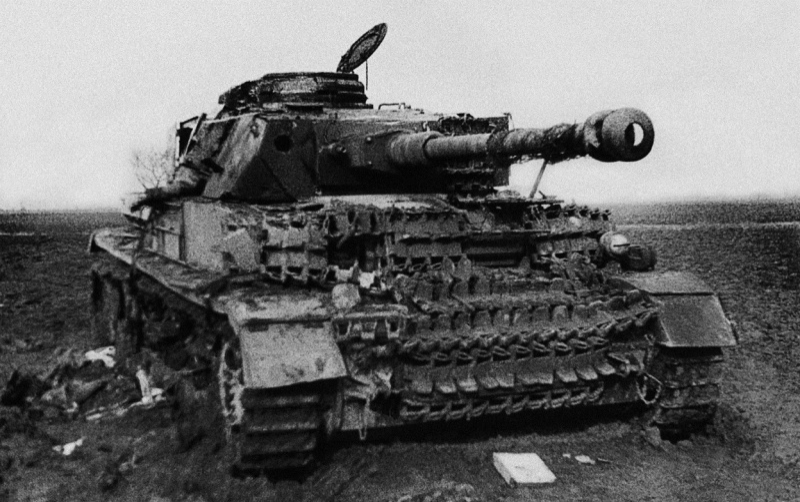
The wounded in battles at Breslau and completely burned medium tank Pz.Kpfw.IV Ausf. H later release. Tank incapacitated only hit 76-mm armor-piercing projectile on the forehead of the tower. housing forehead almost completely closed track shoes to enhance protection.
Chassis
Chassis Pz.Kpfw.IV for a board composed of eight doubles rubber rollers diameter 470 mm, four, or (parts Ausf.J) three double support rollers - rubber coated on most machines, for isklyucheniem Ausf.J and parts Ausf.H, the driving wheel and the idler. Road wheels were interlocked in pairs on the balancing suspension leaf springs on chetvertellipticheskih.
Caterpillars Pz.Kpfw.IV - Steel, melkozvenchatye, lantern meshing, odnogrebnevye. In the early versions had a width of caterpillar 360 mm at step 120 mm and consisted of 101 track Kgs 61/360/120. Since modifications Ausf.F, due to the increased weight of the tank caterpillar Kgs was used 61/400/120 width 400 mm, and the number reduced to shoe 99. Later it was introduced trucks with additional lugs, for better grip with the icy surface in winter conditions. Besides, on the Soviet-German front on the track sometimes installed various types of extenders.
Machines based on the Panzerkampfwagen IV
serial
– Assault gun IV (StuG IV) - the average weight of self-propelled artillery unit class assault guns.
– rhino (hornet) - the average weight of an anti-self-propelled artillery unit.
– Möbelwagen 3,7 cm Flak on FGST Pz.Kpfw. IV (sf); Flakpanzer IV «Möbelwagen» - self-propelled anti-aircraft weapon.
– Jagdpanzer IV - the average weight of self-propelled artillery unit class tank destroyers.
– Munitionsschlepper - conveyor ammunition for self-propelled mortars type Gerat 040/041 («Karl»).
– Brummbär (Brummbär) - the average weight of self-propelled artillery unit class assault gun / samohodnaya howitzer.
– Hummel - samohodnaya howitzer.
– Flakpanzer IV (2cm Vierling) Wirbelwind - self-propelled anti-aircraft weapon.
– Flakpanzer IV (3.7cm FlaK) Ostwind - self-propelled anti-aircraft weapon.
experienced
– PzKpfw IV Hydrostatic - modification of the hydrostatic drive.
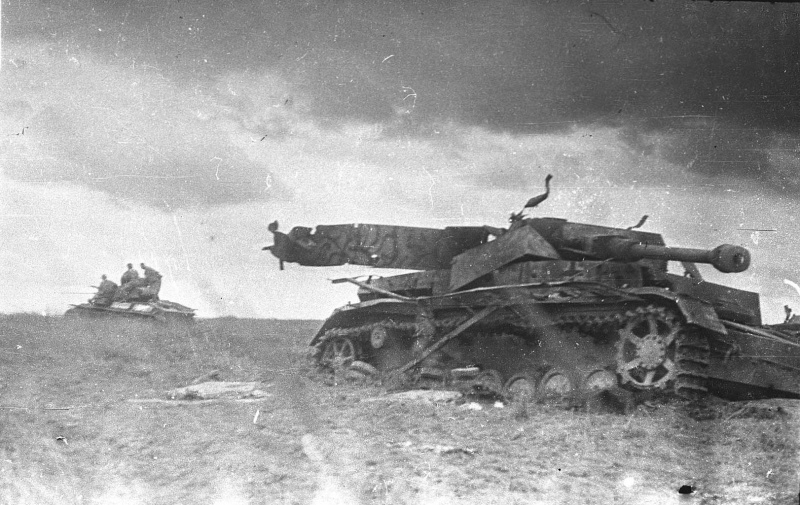
Destroyed German medium tank Pz.Kpfw. IV on the Kursk Bulge. In the background, the receding Soviet light tank T-70 with the soldiers.
combat application
early years
The first three Pz.Kpfw.IV Ausf.A came to the troops by January 1938 of the year, and by April the number of this type of tanks in the army has increased to 30. In April of the same year Pz.Kpfw.IV used during the Anschluss, and in October - during the occupation of the Sudetenland of Czechoslovakia. But although the number of part, as well as the rate of production, steadily increased, before the Second World War were less than Pz.Kpfw.IV 10 % from the tank fleet of the Wehrmacht. Number Pz.Kpfw.IV tanks (75-short-mm cannon Kwk 37, two machinegun 7,92 mm) on 1 June 1941 years in the army - 439.
The Second World War
Export
tank Pz.Kpfw. IV exported to various countries. In 1942-1944 gg. Germany exported 490 machines.
postwar use
Also, the tank was used in many battles since World War II: He was actively used by the IDF, Armed Forces of the Syrian army and other Middle Eastern countries during the wars of 1950-1970 GG, namely: Israel's War of Independence 1948-1949 yy, Suez conflict 1956 g,Six-Day War 1967 year and other conflicts. Also used the armies of Iraq and Iran in the Iran-Iraq war of 1980-1988 yy.
For a long time I was in service Europe-Hungary armies, Bulgaria, Finland, France, Croatia and Spain, etc..
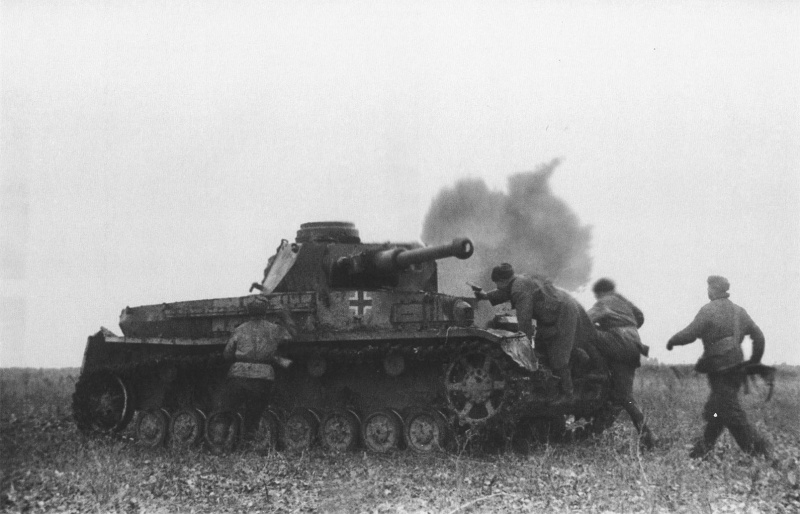
The Red Army seized padded on the battlefield near Mozdok German tank Pz.Kpfw. IV Ausf F-2. In the tank there is no exchange machine gun.
Performance characteristics of the T-4
Crew, pers.: 5
developer: Krupp
Manufacturer: Friedrich Krupp AG Hoesch-Krupp
years of production: 1936—1945
years of operation: 1939—1970
The number of issued, PC.: 8686
Weight of tank T-4
– 24 tonnes
Dimensions of the T-4
– body Length, mm: 5890
– housing width, mm: 2880
– Height, mm: 2680
Armor tank T-4
– Type broni: steel forged and rolled with surface hardened
– housing forehead, mm / city.: 80
– body board, mm / city.: 30
– housing feed, mm / city.: 20
– tower forehead, mm / city.: 50
– board towers, mm / city.: 30
– tower feed, mm / city.: 30
– tower roof, mm: 18
Arming of the T-4
– Caliber guns and stamp: 75-мм KwK 37, KwK 40 L/43, KwK 40 L/48
– barrel length, calibres: 24, 43, 48
– gun ammunition: 87
– Shotgun: 2 Mm × 7,92-MG-34
Engine tank T-4
– Engine power, l. from.: 300
The rate of tank T-4
– Road speed, kmh: 40
– Cruising on the highway, km: 300
– power density, l. p. / m: 13
Photo T-4
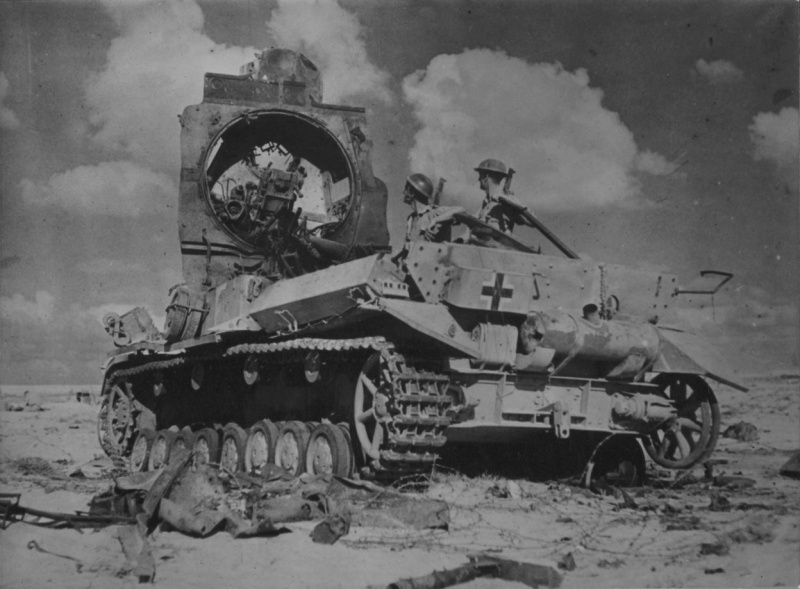
Two British soldiers inspect a German tank exploded Pz.Kpfw.IV in the desert of North Africa. So it was blown up by the British Squad for the impossibility of its evacuation.
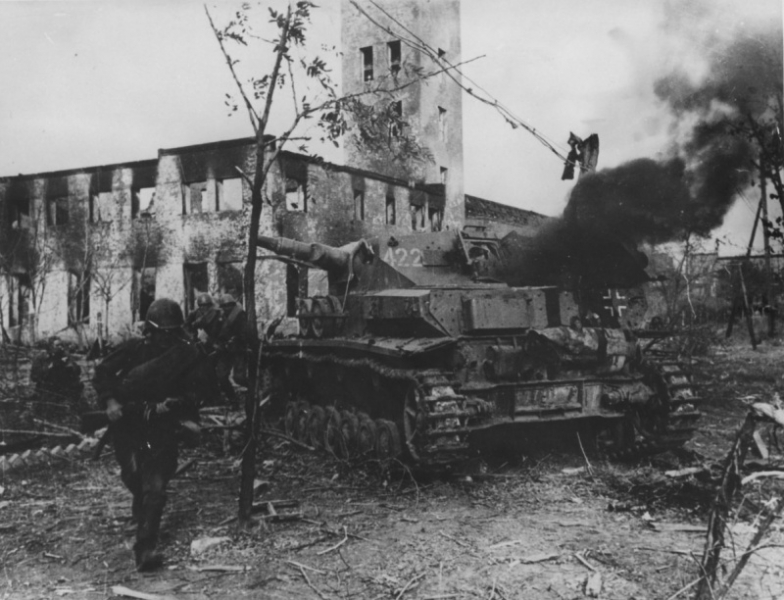
Soviet soldiers moved past the steaming German tank Pz.Kpfw. IV. in the town of Krasnoarmeysk (Now Volgograd region), about Stalingrad shipyard (factory number 264). The building in the photo - a fire station near the entrance of the plant.
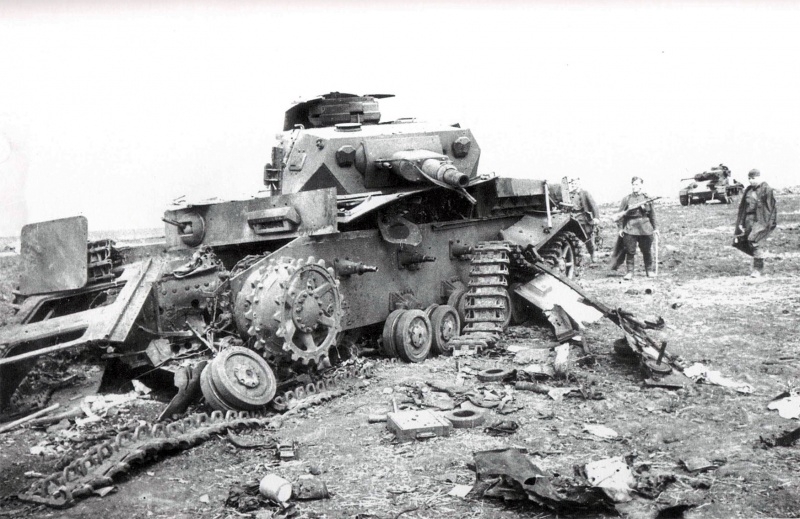
Gunners Soviet 6th Tank Brigade inspect wrecked German tanks Pz.Kpfw. IV (in the foreground) и Pz.Kpfw. III. Southwestern Front.







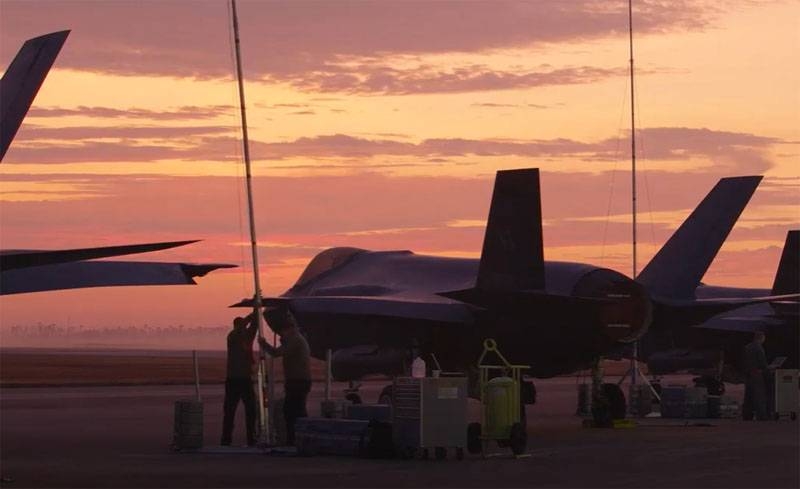




well narmalno. But it is not all right.
Namely what is wrong?